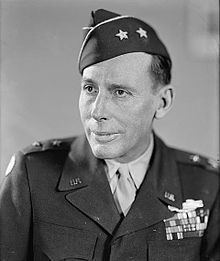Nickname(s) Butts Years of service 1916 - 1947 | Rank Major General Name Butler Miltonberger | |
 | ||
Allegiance United States of America Battles/wars Mexican Border CampaignWorld War IWorld War IIBattle of NormandyBattle of the Bulge Battles and wars Pancho Villa Expedition, World War I, Operation Overlord, Battle of the Bulge, World War II | ||
Commands held 134th Cavalry Regiment | ||
Butler Buchanan Miltonberger (August 31, 1897 – March 23, 1977) was a United States Army Major General who served as Chief of the National Guard Bureau.
Contents
- Early years
- World War I
- Post World War I
- World War II
- Chief of National Guard Bureau
- Later career
- Death and burial
- Awards and decorations
- References
Early years
Butler Buchanan Miltonberger was born in North Platte, Nebraska, on August 31, 1897. He graduated from North Platte High School in 1916 and enlisted in the Nebraska Army National Guard. Miltonberger was mobilized during the Mexican Border Campaign.
World War I
During World War I, Miltonberger fought in the Argonne region with the 4th Infantry Division, and attained the rank of First Sergeant.
Post World War I
In early 1923 Miltonberger was commissioned a First Lieutenant. He was quickly promoted to Captain as commander of Company D, 134th Infantry Regiment. The regiment trained in Nebraska and at out of state locations including Fort Ord and Camp San Luis Obispo in California, Camp Butler in North Carolina, and Camp Rucker in Alabama.
As a civilian, he worked in North Platte as a postman, and was also employed in road and bridge surveying and construction.
Miltonberger was promoted to Major in 1933. In 1935 his unit was mobilized in response to an ongoing dispute between labor and management at the Omaha Traction Company and a flood on the Republican River.
In 1939 he single-handedly captured Willard Brucks, an escaped killer from Ohio who had broken into the Omaha armory to seize weapons.
Miltonberger was promoted to Lieutenant Colonel in 1940.
World War II
At the beginning of the World War II, Miltonberger was promoted to Colonel as commander of the 134th Infantry Regiment. He led his regiment throughout France, including Morhange, Vire, Alsace, Saint-Lô, Geilenkirchen, Bastogne, Mortain, Nancy, Sarreguemines, and the Elbe River.
In February, 1945 Miltonberger was promoted to Brigadier General and assigned as Assistant Division Commander of the 35th Division. In November, 1945 he returned to the United States and remained on active duty at the War Department.
Chief of National Guard Bureau
In 1946 President Harry S. Truman, a fellow veteran of the 35th Division, nominated Miltonberger to be Chief of the National Guard Bureau as a Major General. As Chief Miltonberger worked to reorganize the National Guard following its mobilization for World War II, including the formation of the Air National Guard.
Miltonberger retired from the military in August, 1947 because of poor health.
Later career
After his retirement, Miltonberger returned to Nebraska. He resided in North Platte and Lincoln, and was employed by the Nebraska State Engineer.
In 1950 he became Chairman of the "Miltonberger Board", which consisted of current and former National Guard officers and was empowered to review the National Guard's organizational structure, internal policies and operational procedures,and make recommendations for long term improvements.
Death and burial
Miltonberger died in North Platte on March 23, 1977. He is buried at Fort McPherson National Cemetery near Maxwell, Nebraska.
Awards and decorations
Miltonberger awards included the Distinguished Service Medal, Silver Star, Legion of Merit, Bronze Star Medal, the French Croix de Guerre, the Netherlands Order of Orange-Nassau, the Luxembourg War Cross and the Combat Infantryman Badge.
